This post may include affiliate links; see our disclosure policy.
Learn how to make authentic fougasse bread with this step-by-step guide. This crispy French flatbread features a beautiful leaf shape and takes just 30 minutes of hands-on time.

On a trip to the South of France, I was intrigued by a beautiful leaf-shaped bread in a bakery. After the first bite, I became a fast fan of this French flatbread! It’s crispy on the outside, fluffy on the inside, and delightfully salty, like a French version of focaccia. “It’s so good!” I mumbled, with my mouth stuffed.
As a cookbook author, I knew just what to do when I got back home: learn how to make my own fougasse! After lots of research and many recipe tests, I think I’ve got it down. This recipe makes in fougasse bread that’s fluffy, savory, and flavored with Parmesan, rosemary, and flaky salt. It’s the perfect appetizer that will impress everyone!
5 Star Reader Review
⭐⭐⭐⭐⭐ “This is such a simple recipe but the end result looks quite fancy. It’s perfectly chewy and springy. I feel like I have travelled to France and am sitting at a little outdoor table at a cafe!” -Tanvee
What Makes Fougasse Bread Special
Fougasse is a rustic bread from the French region of Provence, known for its leaf-like shape and crispy crust. What sets it apart is its distinctive leaf-like shape created by slashing the dough before baking.
The Italian version of thsi bread, focaccia, is thicker and more dimpled, but fougasse is slightly flatter and crispier. It’s typically made with simple ingredients like flour, water, yeast, and olive oil, and can be flavored with toppings like herbs, olives, cheese, or cured meats. Fougasse can be enjoyed on its own, dipped in olive oil, or served as an accompaniment to soups, salads, or other dishes.
Making Fougasse Bread: An Overview
Fougasse takes about 4 ½ hours total, with about 30 minutes hands-on time. It’s best to make it on a weekend or a day off when you have time to intersperse the steps into your daily rhythm. Here’s an outline of the steps required:
| Mix and rest (autolyse) | 5 minutes active, 1 hour hands off |
| Knead the dough | 10 minutes active |
| First rise | 1 ½ to 2 hours, hands off |
| Shape the dough | 5 minutes active |
| Second rise | 30 minutes, hands off |
| Bake | 5 minutes active, 15 minutes hands off |
| Cool | 15 minutes hands off |

Ingredients You’ll Need
You’ll need a handful of ingredients to make fougasse bread. Try to stick to these ingredients! I tested this recipe with all-purpose flour, and the texture was noticeably not as springy. Here’s what you’ll need:
- Bread flour: Bread flour is important because it has higher protein content, making the bread texture more chewy than crumbly. Do not substitute all-purpose flour.
- Whole wheat flour: Whole wheat flour adds a nutty, complex flavor to this bread.
- Active dry yeast: Look for active dry yeast, not instant yeast. Yeast should be stored in the freezer.
- Water and salt: Water and salt round out the ingredients in bread.
- Olive oil, grated Parmesan cheese, fresh rosemary, and sea salt: These topping ingredients add a savory pop to the bread and are required. Make sure to use grated Parmesan (with a powdery texture), not shredded Parmesan (with a shredded texture).
The Autolyse Method
This recipe starts with autolyse, a word that sounds fancy but simply means mixing flour and water and letting them rest before adding salt and yeast. I’ve found this technique makes the dough significantly easier to work with and creates better texture in the final bread (for example, in my sourdough bread recipe).
During that 1-hour rest, the gluten structure starts to develop naturally. This means less kneading and a dough that’s easier to shape into that signature leaf pattern.
Shaping the Leaf Pattern
I’ll be honest: Alex is the bread expert over here, and he researched and developed this method for shaping the leaf pattern of the dough, which works wonderfully.
The key is using wet fingers to open up each slash after cutting. Don’t just cut the dough: actually pull the cuts apart to separate them. If you skip this, the slashes will close up while baking. Using a pizza cutter or pastry cutter works better than a knife.
Why the Steam Matters
You’ll notice this recipe calls for adding hot water to a baking sheet during the initial baking phase. This creates steam in the oven, which is crucial for developing the crispy exterior of the dough.
I tested batches both with and without the steam step, and the difference is dramatic—the steamed versions rose higher and had much better crust texture.
Troubleshooting Tips For Fougasse
Dough won’t rise: Check that your yeast is fresh and that the water temperature is lukewarm, not hot (around 100-110°F). Water that’s too hot will kill the yeast.
Bread is too dense: This usually happens when too much flour is added during kneading. The dough should be slightly sticky: resist the urge to add too much additional flour.
Slashes close up during baking: Make sure to really open up the cuts with wet fingers before the final rise. The slashes should be clearly separated before baking.
Creative Topping Ideas
Fougasse works well with toppings. The fougasse I ate in France had different types of cheeses and meats! Try adding sliced black olives, other types of cheese, sun-dried tomatoes, roasted garlic, or even cured meats.
Storing Leftovers
Store the fougasse bread wrapped in cloth or in a bread bag on the counter for up to 2 days. This allows the bread to “breathe.” Avoid storing in plastic since it becomes soft and moist. You can also freeze the bread wrapped in foil in a plastic bag for several months.
Dietary notes
This fougasse bread recipe is vegetarian. For vegan, omit the Parmesan cheese or use vegan Parmesan.
Frequently asked questions
Yes, fougasse and focaccia share similarities in their flatbread shape and use of olive oil. However, fougasse has a crispier texture and a distinct leaf-like shape with decorative slashes.
Bread flour is best for a slightly chewier texture.
After shaping the dough into an oval, use a sharp knife or a lame (a baker’s scoring tool) to make diagonal slashes across the surface, resembling a leaf’s veins.
Store fougasse at room temperature in an airtight container for up to 2 days. Reheat it briefly in the oven for the best texture.
Fougasse Bread
Learn how to make authentic fougasse bread with this step-by-step guide. This crispy French flatbread features a beautiful leaf shape and takes just 30 minutes of hands-on time.
- Prep Time: 4 hours 15 minutes
- Cook Time: 15 minutes
- Total Time: 4 hours 30 minutes
- Yield: 1 large loaf 1x
- Category: Bread
- Method: Baked
- Cuisine: French
- Diet: Vegetarian
Ingredients
Ingredients:
- 280 grams (2 cups) bread flour
- 46 grams (⅓ cup) whole wheat flour
- 1 teaspoon (7 grams) kosher salt
- 1 teaspoon (4 grams) active dry yeast
- 1 cup (236 g) lukewarm water
Topping:
- 1 tablespoon olive oil
- Sea salt
- Fresh grated Parmesan cheese
- 1 tablespoon chopped fresh rosemary
Instructions
- Prepare and rest ingredients (1 hour): In a medium bowl, combine the bread flour, whole wheat flour, and water and stir until ragged dough forms. Cover with a damp towel or plastic wrap. Rest 1 hour (this is called autolyse).
- Knead the dough (10 minutes): After the rest, flatten the dough and sprinkle with the kosher salt and yeast. Wet your fingers to prevent sticking and knead a few times to incorporate the ingredients into the dough.
- Transfer the dough to the bowl of your stand mixer with the dough hook attached. Knead on medium low speed for 8 minutes. The dough should form a ball, but remain rather sticky. If a ball does not form, add a sprinkle of flour. Alternatively, knead by hand for 8 minutes on a lightly-floured counter. You may need to add a sprinkle of flour to get the dough to form a ball, but resist the urge to add too much flour.
- First rise (1 ½ to 2 hours): Place the kneaded dough in a lightly oiled bowl, cover with a damp towel or plastic wrap and allow to rise in a warm location until doubled in size and very bubbly, 1 ½ to 2 hours.
- Shape the fougasse (5 minutes): Lay a piece of parchment paper on a countertop. Scrape the dough onto the parchment paper and use your fingers to press the dough into a large, slightly pointed oval about 1/2” thick (see photo). Use a pizza roller or pastry cutter to cut a line down the middle to mimic the leaf stem shape, then use wet fingers to gently open the slice (this helps to form the separation of each leaf). Repeat with 3 cuts on each side to finish the leaf design, opening each slightly.
- Second rise (30 minutes): Moisten the top of the dough with water, then cover with a damp towel or plastic wrap. Rest 30 minutes, until slightly puffy.
- Meanwhile, place a pizza stone in the middle rack of the oven. Place an empty, rimmed baking sheet on the rack below. Preheat the oven to 450°F.
- Garnish and bake (20 minutes): After the rest, brush the top of the dough with the olive oil. Sprinkle generously with sea salt, Parmesan cheese, and chopped rosemary.
- Slide an un-rimmed cookie sheet under the parchment and use it like a pizza peel to transfer the dough on the parchment paper to the pizza stone.
- Carefully add 2 cups of hot tap water to the hot baking sheet below, being very careful not to let the steam burn your hands. (The steam helps the bread to have a better rise and texture.)
- Bake in the oven for 13 to 16 minutes or until golden brown and crisp, rotating the bread (by moving the parchment paper) after 10 minutes for even browning.
- Cool and serve: Remove the bread from the oven and allow it to cool on a wire rack at least 15 minutes before serving. Store the bread wrapped in cloth or in a bread bag on the counter for up to 2 days, or freeze wrapped in foil in a plastic bag for several months.
Notes
This dough is easiest to make in a stand mixer, but if you don’t have one you can hand knead!
More Homemade Bread Recipes
- Best Sourdough
- Baguette Recipe
- Sandwich Bread
- No Knead Bread
- Focaccia Bread
- Whole Wheat Bread
- Olive Bread


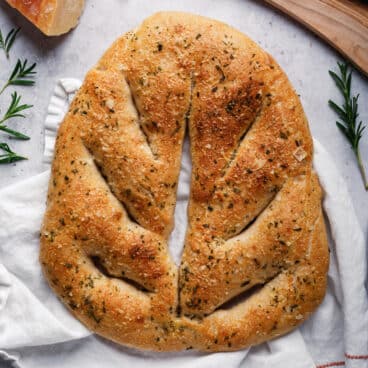
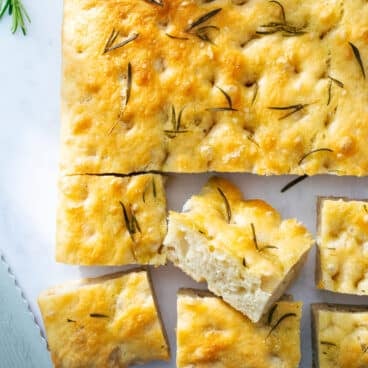
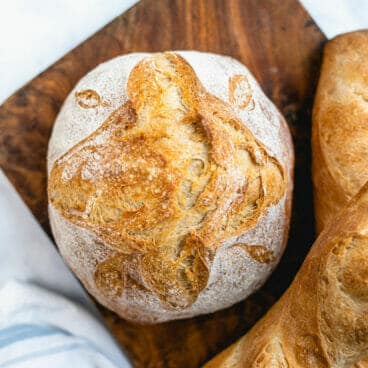
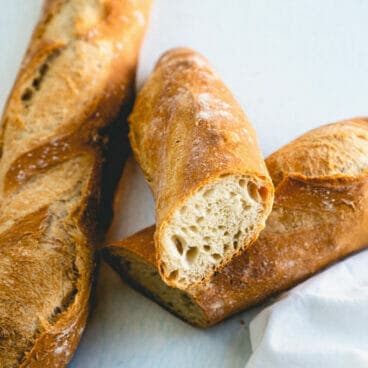
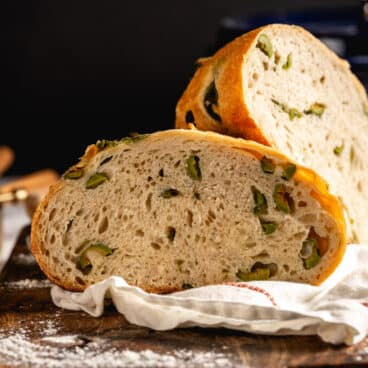


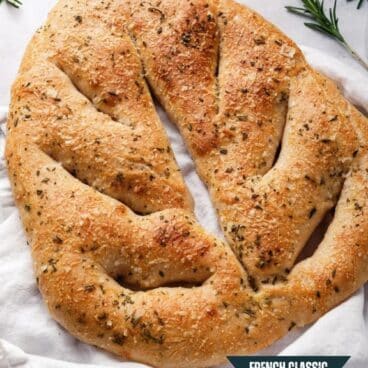
This is such a simple recipe but the end result looks quite fancy. It’s perfectly chewy and springy. I feel like I have travelled to France and am sitting at a little outdoor table at a cafe!
Excellent
Let us know if you have any questions!